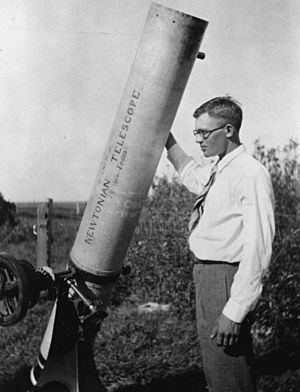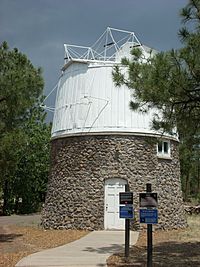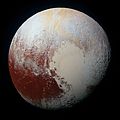Clyde Tombaugh facts for kids
Quick facts for kids
Clyde William Tombaugh
|
|
|---|---|

Tombaugh at his family's farm with his homemade telescope
|
|
| Born | February 4, 1906 in a ranch near Streator, Illinois, U.S.
|
| Died | January 17, 1997 (aged 90) Las Cruces, New Mexico, U.S.
|
| Nationality | American |
| Occupation | Astronomer |
| Known for | Discovery of Pluto |
Clyde William Tombaugh February 4, 1906-January 17, 1997 was an American astronomer. He discovered Pluto in 1930, the first object to be discovered in what would later be identified as the Kuiper belt. At the time of discovery, Pluto was considered a planet but was later reclassified as a dwarf planet in 2006. Tombaugh also discovered many asteroids. He also called for the serious scientific research of unidentified flying objects, or UFOs.
Life and career
Tombaugh was born in Streator, Illinois. In 1922, Tombaugh's plans for attending college were frustrated when a hailstorm ruined his family's farm crops.
Starting in 1926, he built several telescopes with lenses and mirrors by himself. To better test his telescope mirrors, Tombaugh, with just a pick and shovel, dug a pit 24 feet long, 8 feet deep, and 7 feet wide. This provided a constant air temperature, free of air currents, and was also used by the family as a root cellar and emergency shelter.
He sent drawings of Jupiter and Mars to the Lowell Observatory, which offered him a job. Tombaugh worked there from 1929 to 1945.
Following his discovery of Pluto, Tombaugh earned bachelor's and master's degrees in astronomy from the University of Kansas in 1936 and 1938. During World War II he taught naval personnel navigation at Northern Arizona University. He worked at White Sands Missile Range in the early 1950s, and taught astronomy at New Mexico State University from 1955 until his retirement in 1973.
The asteroid 1604 Tombaugh, discovered in 1931, is named after him. He discovered hundreds of asteroids, beginning with 2839 Annette in 1929, mostly as a by-product of his search for Pluto and his searches for other celestial objects. Tombaugh named some of them after his wife, children and grandchildren. The Royal Astronomical Society awarded him the Jackson-Gwilt Medal in 1931.
In 1980, he wrote a book "Out of the Darkness: The Planet Pluto" with Patrick Moore. In August 1992, JPL scientist Robert Staehle called Tombaugh, requesting permission to visit his planet. "I told him he was welcome to it," Tombaugh later remembered, "though he's got to go one long, cold trip." The call eventually led to the launch of the New Horizons space probe to Pluto in 2006. Following the passage on July 14, 2015 of Pluto by the New Horizons spacecraft the "Cold Heart of Pluto" was named Tombaugh Regio.
Discovery of Pluto
While a young researcher, Tombaugh was given the job to perform a systematic search for a trans-Neptunian planet (also called Planet X), which had been predicted by Percival Lowell and William Pickering.
The discovery was made on Tuesday, February 18, 1930, using images taken the previous month. The name "Pluto" was suggested by an 11-year-old schoolgirl. It won out over numerous other suggestions because it was the name of the Roman god of the underworld, who was able to render himself invisible, and because Percival Lowell's initials PL formed the first 2 letters. The name Pluto was officially adopted on May 1, 1930.
Asteroids discovered
Tombaugh is officially credited by the Minor Planet Center with discovering 15 asteroids, and he observed nearly 800 asteroids during his search for Pluto and years of follow-up searches looking for another candidate for the postulated Planet X. Tombaugh is also credited with the discovery of periodic comet 274P/Tombaugh–Tenagra. He also discovered hundreds of variable stars, as well as star clusters, galaxy clusters, and a galaxy supercluster.
| Designation | Discovery |
|---|---|
| 2839 Annette | October 5, 1929 |
| 2941 Alden | December 24, 1930 |
| 3310 Patsy | October 9, 1931 |
| 3583 Burdett | October 5, 1929 |
| 3754 Kathleen | March 16, 1931 |
| 3775 Ellenbeth | October 6, 1931 |
| 3824 Brendalee | October 5, 1929 |
| 4510 Shawna | December 13, 1930 |
| 4755 Nicky | October 6, 1931 |
| 5701 Baltuck | November 3, 1929 |
| 6618 Jimsimons | September 16, 1936 |
| 7101 Haritina | October 17, 1930 |
| 7150 McKellar | October 11, 1929 |
| (8778) 1931 TD3 | October 10, 1931 |
| 134340 Pluto | January 23, 1930 |
Death
Tombaugh died on January 17, 1997, when he was in Las Cruces, New Mexico, at the age of 90. He was cremated. A small portion of his ashes was placed aboard the New Horizons spacecraft.
Images for kids
See also
 In Spanish: Clyde Tombaugh para niños
In Spanish: Clyde Tombaugh para niños






